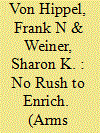| Srl | Item |
| 1 |
ID:
190277


|
|
|
|
|
| Summary/Abstract |
In 1958, the Soviet physicist Andrei Sakharov published an estimate of the long-term health impacts from carbon-14 produced by nuclear test explosions in the atmosphere. At the time, Sakharov was an important contributor to the Soviet Union's development of multi-megaton thermonuclear weapons. This was Sakharov's first public expression of concern about the weapons work in which he was involved. Subsequently, he became a campaigner for human rights in the Soviet Union and for international cooperation and received the 1975 Nobel Peace Prize in recognition of the importance of his efforts. This article provides some context for his estimate and compares it with estimates based on dose estimates by the UN Scientific Committee on Effects of Atomic Radiation and dose-effect estimates by the US National Academies.
|
|
|
|
|
|
|
|
|
|
|
|
|
|
|
|
| 2 |
ID:
083200


|
|
|
| 3 |
ID:
168011


|
|
|
|
|
| Summary/Abstract |
In October 2018, the U.S. National Nuclear Security Administration (NNSA) announced its decision to reestablish a domestic uranium-enrichment capability in the United States.1 As described in its fiscal year 2019 Stockpile Stewardship Management Plan, the NNSA said there is a pending shortage of U.S.-origin low-enriched uranium (LEU) needed to fuel the nuclear reactors that produce the tritium gas used in U.S. nuclear weapons. The NNSA initially estimated a need for new supplies of LEU by 2027, but after an internal review identified additional materials, this date was deferred until at least 2038.2
|
|
|
|
|
|
|
|
|
|
|
|
|
|
|
|
| 4 |
ID:
149610


|
|
|
|
|
| Summary/Abstract |
This article reviews the case of the spent fuel fire that almost happened at Fukushima in March 2011, and shows that, had the wind blown the released radioactivity toward Tokyo, 35 million people might have required relocation. It then reviews the findings by the United States Nuclear Regulatory Commission (NRC) in 2013 that the consequences of a loss-of-water event could be drastically reduced if spent fuel were moved to dry storage after 5 years of pool cooling but that the probability of a spent fuel pool fire is too low to make this a requirement. Our atmospheric dispersion and deposition calculations using HYSPLIT for hypothetical releases from the Peach Bottom plant in Pennsylvania find average interdicted areas and populations requiring relocation larger than NRC estimates presented to the National Academy of Sciences (NAS) and support the NAS findings of errors and omissions in the NRC's cost-benefit calculations. Political pressures from industry on the NRC may be biasing its analyses toward regulatory inaction.
|
|
|
|
|
|
|
|
|
|
|
|
|
|
|
|
| 5 |
ID:
170233


|
|
|
|
|
| Summary/Abstract |
Science & Global Security marks its 30th anniversary this year. Discussions leading to the journal began in the mid-1980s between Roald Sagdeev, Vitali Goldanski and Sergei Kapitza on the Soviet side and the two of us on the U.S. side. The objectives of the journal from the beginning were to publish high quality technical papers on arms control, international security, and global environmental issues; to open communication between western and Soviet scientists and arms control analysts; and above all, to develop a shared understanding of the technical basis for new policy initiatives to reduce the dangers from nuclear weapons. The journal was to be guided by a board of editors consisting of both western and Soviet scientists and arms control experts.
|
|
|
|
|
|
|
|
|
|
|
|
|
|
|
|